Dog nose hyperkeratosis (which shows up as a dry, crusty, and/or cracked nose) can be unsightly and sometimes even uncomfortable for affected dogs. Integrative veterinarian Dr. Julie Buzby takes a look at nine reasons a dog may develop nasal hyperkeratosis and discusses how best to help soothe and moisturize your pup’s sniffer.
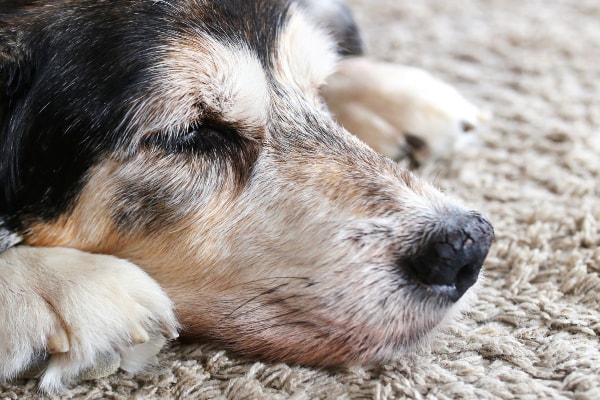
It’s a common misconception that a warm and dry nose means a dog is sick. In truth, noses aren’t really affected by most canine illnesses. Plenty of sick dogs have a cold, moist nose. And a warm, dry nose can be totally normal in some situations.
However, there are dog health conditions that do affect the appearance of your dog’s nose. And some of them result in dog nose hyperkeratosis.
What is dog nose hyperkeratosis?
Hyperkeratosis is the term for the thickening of the outermost layer of skin (i.e. stratum corneum). It occurs due to excessive accumulation of a fibrous protein called keratin, which is the main structural component for skin, hair, and nails.
Canine hyperkeratosis can occur in many places. But the most common locations are:
- Nose and/or paw pads (i.e. nasodigital hyperkeratosis)
- Pressure points (e.g. dog elbow calluses or calluses in other locations)
Dog paw pad hyperkeratosis will be the subject of another article in the future. But the focus here is going to be dog nose hyperkeratosis.
What are the symptoms of dog nose hyperkeratosis?
Dogs with nasal hyperkeratosis typically have a dry, crusty nose that appears to have bumps or ridges of extra tissue (i.e. excess keratin). Hyperkeratosis can affect all parts of the non-haired portion of the nose (i.e. the nasal planum). But it seems to be especially prominent on the top of the nose.
As a side note, dogs with dried nasal discharge from a respiratory illness can look like they have hyperkeratosis. But nasal discharge can be gently cleaned away, whereas hyperkeratosis cannot.
Sometimes hyperkeratosis is mild and primarily cosmetic. But in other cases, it can lead to deep, painful fissures in the nose which are prone to bleeding or infection. Much of the severity depends on the underlying cause of the hyperkeratosis.
What are the causes of dog nose hyperkeratosis?
In some situations, the hyperkeratosis is a stand-alone problem. But in other conditions, hyperkeratosis may just be one of the many symptoms.
Some causes of hyperkeratosis include:
#1: Breed
There are some dog breeds with a genetic predisposition toward developing nasal hyperkeratosis.
- Labrador Retrievers have an increased risk of nasal parakeratosis, a genetic condition that results in hyperkeratosis of just the nose.
- French Mastiffs and Irish Terriers are more likely to develop naso-plantar keratoderma, which causes thickening of the skin on the nose and the paws.
- Golden Retrievers, Cocker Spaniels, and Bedlington Terriers are also genetically more prone to the development of nasal hyperkeratosis.
Additionally, the conformation of the face of certain dog breeds—namely brachycephalic dogs— also seems to predispose them to nose hyperkeratosis. Brachycephalic breeds like Pugs and English Bulldogs have a very short nose and wide head. This makes it harder for them to lick their noses to keep them moist.
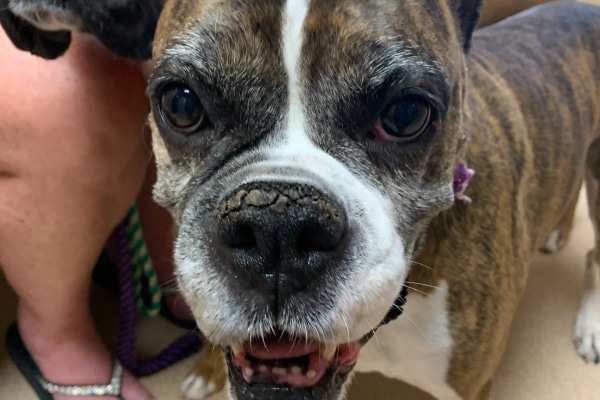
And their face conformation also means that that their nose may have less contact with food bowls or other surfaces in the environment. This can make them more likely to develop nasal hyperkeratosis because normally some of the keratin on the nose gets worn away as it rubs against hard surfaces.
#2: Age
As dogs reach their senior years, the tissue in certain areas, including the nose, may get thicker. This can lead to nose hyperkeratosis. Plus, older dogs don’t always do as much investigating of their environment, so they may be less likely to wear away the keratin on their noses.
The two contributing factors we just discussed—age and breed—are fairly harmless causes of nasal hyperkeratosis. But excessive keratin build-up on the nose can also be a feature of certain more problematic medical conditions.
#3: Canine distemper
Canine distemper is a viral infection that affects many systems in a dog’s body. It can start by targeting the respiratory and gastrointestinal tracts, resulting in symptoms like nasal discharge, vomiting, and diarrhea. Distemper may also progress to neurologic signs like stumbling and seizures in dogs. And some strains of the virus are known to cause nose or paw pad hyperkeratosis in dogs that survive the initial infection.
#4: Zinc responsive dermatosis
The mineral zinc is an essential nutrient for dogs. It is a normally part of a balanced and complete commercial diet, but dogs (especially rapidly-growing puppies) can develop a zinc deficiency if they are eating a poorly-balanced or zinc-deficient diet. Also, arctic breeds like the Siberian Husky and the Alaskan Malamute can have a genetic inability to absorb or use zinc. This can lead to inadequate levels of zinc in the body.
Dogs suffering from a zinc deficiency may have:
- Immune system dysfunction
- Stunted growth
- Nose hyperkeratosis
- Thickening of the skin
- Grey scales or crusts on the skin
- Hair loss
- Reddened skin
- Greasy haircoat
These skin-related changes tend to occur around the eyes, ears, and mouth; or on the footpads or nose. Since many of these symptoms involve the skin, this condition is often called zinc responsive dermatosis.
#5: Superficial necrolytic dermatitis
Superficial necrolytic dermatitis is also known as hepatocutaneous syndrome (i.e. liver and skin syndrome) because it is a skin condition that tends to be associated with liver disease in dogs. Some affected dogs may have diabetes in dogs too.
Dogs with superficial necrolytic dermatitis tend to have severe crusting and hyperkeratosis involving their legs, paw pads, nose, and the area around the eyes. Plus, they have systemic signs like weight loss, being a lethargic dog, vomiting, diarrhea, increased thirst in dogs, or increased urination.
#6: Pemphigus foliaceus
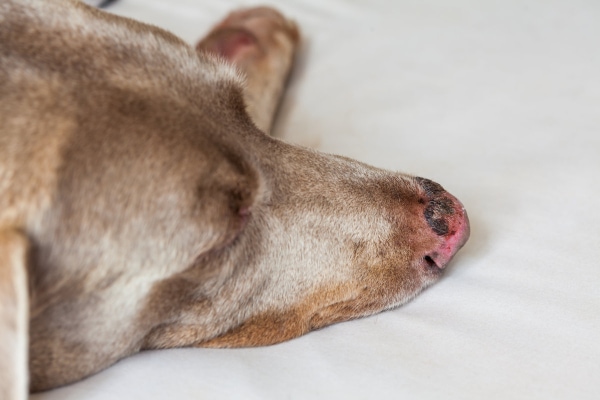
Pemphigus foliaceus is one of several autoimmune skin conditions that can cause hyperkeratosis and open sores around the ears, face, and nose. It predominantly affects middle-aged and senior dogs. And the main triggers are chronic inflammation, cancer, or damage from the sun’s UV rays.
#7: Discoid lupus erythematosus (DLE) and systemic lupus erythematosus (SLE)
Two other autoimmune disorders that can cause nose hyperkeratosis are discoid lupus erythematosus (DLE) and systemic lupus erythematosus (SLE). Research has not yet uncovered the cause of either disorder, but genetic and environmental factors (e.g. sunlight) may play a role in disease development. While SLE can attack both the skin (including the nose) and the joints, DLE mostly affects the nose.
#8: Leishmaniasis
The bite of a sand fly transmits the protozoan parasite that causes leishmaniasis. Dogs and people who live in areas where the disease is common, such as India, Brazil, Iraq, and some southern European countries, are more likely to develop Leishmaniasis. However, it is spreading to more countries all the time.
Leishmaniasis can cause many clinical signs such as fever, loss of appetite, vomiting, diarrhea, weight loss, or increased thirst and urination. Dog nose bleeds and nasal hyperkeratosis are also possible.
#9: Hypothyroidism
Your dog’s body normally produces thyroid hormones, which control growth and metabolism. However, in hypothyroidism in dogs, thyroid hormone levels are too low. Common signs of hypothyroidism include lethargy, trouble losing weight, and poor skin and coat quality. However, paw pad or nose hyperkeratosis develops in some hypothyroid dogs as well.
How do you find the cause of the nose hyperkeratosis?
As you can see, there are a wide variety of conditions that answer the question, “Why is my dog’s nose dry?” Thus, your vet may need to do some sleuthing to figure out how best to help your crusty-nosed pup. If the answer isn’t obvious from the exam or history, your vet may recommend bloodwork, imaging, nasal punch biopsies, testing for hereditary nasal parakeratosis, etc., to rule in or rule out some of the other conditions.
How do you treat hyperkeratosis on a dog’s nose?
Once your vet has a better idea of why your dog has a hyperkeratotic nose, he or she will formulate a treatment plan. Usually it has two main components—treating the underlying cause and managing the hyperkeratosis.
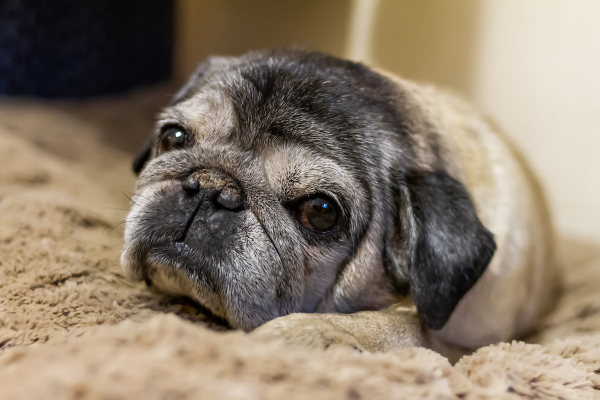
Each medical condition has its own treatment recommendations, so I’m not going to get into those here. However, I do want to discuss some options that may help your dog’s nose look and feel better.
Removing excess keratin
To help treat severe hyperkeratosis, your vet may need to trim away some of the excess keratin before starting any topical therapies.
Rehydrating the tissue on the nose
The vet may also have you rehydrate the dried skin on the nose by wetting a washcloth with warm water and using it to soak your dog’s nose. After soaking, you should apply a petroleum jelly product (e.g., Vaseline) every 24 hours. This home remedy does the trick after about 10 days for some dogs, but other dogs with chronic nasal hyperkeratosis may need daily treatment long-term.
Topical medications
Medicated topical therapies are also available. Some contain steroid and antibiotic ingredients to reduce inflammation or manage secondary infection. Others may contain keratolytic ingredients that can help break down excess keratin. Ingredients such as salicylic acid, lactic acid, sulfur, and tretinoin are all considered to be keratolytics.
Moisturizing products
Topical products like Dermoscent BIO BALM® contain natural ingredients that have been clinically shown to help manage hyperkeratosis on the nose, paw pads, and even elbow calluses. It primarily helps to moisturize dry skin. But since it contains omega-6 and omega-3 fatty acids for dogs, it can also help reduce inflammation.
There are also a variety of other moisturizing dog nose balms for hyperkeratosis on the market. Many contain ingredients like coconut oil, which are okay for dogs if accidentally ingested in small amounts.
However, it’s important to ask your vet about any topical therapies or home remedies that you want to use for your canine companion. And ensure that you do not occlude your dog’s nostrils when applying nose balms or ointments or soaking your dog’s nose.
Sometimes it’s good to be nosy
If you notice your dog may be developing nose hyperkeratosis, keep in mind that much of the time it is mostly cosmetic. However, it can be a sign of a more serious condition.
When in doubt, it is better to “be nosy” and contact your vet than it is to take a “wait and see” approach. This is especially the case if you are seeing any systemic signs (lethargy, vomiting or diarrhea, etc.) or other skin changes (redness, hair loss, crusts, etc.) in addition to the hyperkeratosis. Your vet can examine your dog and advise you about the next best steps.
Hopefully, your dog will just need some snout balms or a nose hydration program. But if the vet does find something more serious, the sooner you can start treatment the better. Therefore, don’t be afraid to “be nosy” and call the vet if you have any concerns about your dog’s health.
Have any of your dogs ever been diagnosed with nasal hyperkeratosis?
Please comment below.

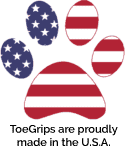
Our pit has developed a very dry nose in the last month. He constantly has gunk packed in his nostrils that cause him to breathe very loud & snore. It started after he had to have eye surgery for his bottom eye lid rolling in. We’ve done all the antibiotics & eye drops but his eye frequently get goopy but there is no moisture in his nose. Vet didn’t seem concerned but I hate that he doesn’t seem to be able to breathe easily.
Hi Susan,
I am sorry your boy is dealing with these ongoing nasal and eye issues. What you describe definitely doesn’t sound like just a “dry nose” and warrants more investigation. It may be a good idea to ask for a consultation with a specialist. I feel certain there is a way to offer your boy relief and improve his quality of life. Hoping for answers and a clear path forward. Best wishes to you both. ♥
My border collie/cavalier mix has had it on the one side of his nose for a while now. I haven’t treated it but am going to start with the warm water/vaseline and see if it helps. I decided to start treating because it seems to be starting on the other side as well. He is otherwise super healthy for a thirteen year old and very active so I don’t suspect any underlying issues. Glad this article was here.
Hi Elizabeth,
I hope the warm water and Vaseline help your dog’s nose and he continues to have otherwise great health!
My American x Australian Bulldog suffers from this. I couldn’t afford to go to the vet at the time I was trying to find a solution. One day, I decided to try this cheap lip balm I use for my dry lips (Dermal Therapy, lip balm original) and decided to try it on her nose. She HATED it and then I got worried there might be ingredients in the balm that is toxic to dogs. So I wiped it off, she was fine and we carried on, not thinking about it any further. About a week later I noticed that some of those growth things had fallen off. I grabbed a tissue and found that I was able to wipe them off her nose. At this stage, some parts were easy and other bits proved to be quite stubborn. I looked up the ingredients to the lip balm to see if any of them were harmful to dogs. Some were, but only if ingested in large amounts. Well, it was going on her nose, I put more on and this time let it stay on. The next day, I was able to wipe off the remainder.
Hi Tui,
I am glad you found a way to resolve this issue your dog was having on her nose. It does make me nervous when thinking about using a product that contains ingredients that are toxic to dogs. I understand you were putting it on her nose, but dogs frequently lick their noses. I would not recommend continuing to use this product but am happy you achieved the results you were looking for. Thanks for sharing!
Maybe it was just hardened dried food or fluid from a runny nose that dried and left a crust ?
Anything with the texture of lip balm would soften any hardened matter and make it easier to remove fairly quickly and certainly overnight.
Instead of lip balm with questionable ingredients you could use organic virgin coconut oil to soften it. Or in a pinch and not regularly even aquaphor would do the trick.
Also, like the article mentions a nose balm formulated for dogs made by a company you trust with simple natural/organic traceable and responsibly sourced ingredient’s would be ideal.
Maybe even consider tapping some on their nose before they bury their face in anything that could potentially become caked and dried on them and it will prevent anything from sticking to them in the first place.
Xoxo
It’s different than stuff just stuck on the nose. Our dog’s
nose feels like very coarse sandpaper; that’s the best way I can describe it.
How do I keep my senior dog from licking off any topical applications?
Hi Mary,
This is a great question but unfortunately one that doesn’t have a great answer. If you are trying to keep a dog from licking other areas of the body, sometimes an E.Collar or other covering can be used. But when it comes to a dog’s nose, preventing licking is almost impossible. This is the reason why anything you apply topically to the nose has to be safe if ingested. Some of my clients have had luck with applying a moisturizer or medication and then using distraction, food, or play to keep their dog busy. If you can keep them preoccupied until the topical has soaked into the tissues or it has dried, you should be ok. Wishing you all the best of luck!
Hi I hv a 5 yr old American Bulldog I got her about 3 months ago she has the crusty nose on top of the nose pad. Is this normal and if so can I wash her face and apply 2x a day???
Hi Jonalee,
I understand your concern for your pup and think it is great you are reaching out for advice. Unfortunately, without examining your girl myself, I can’t make specific conclusions about this issue with her nose. You would need to schedule an appointment to have it evaluated by your vet. They can let you know if this is nose hyperkeratosis or if there are other concerns that need to be tested for and ruled out. Wiping your girl’s face daily with a damp cloth should be fine. I would not recommend using soap or other substances for cleaning unless directed by your vet. I am not sure what you are thinking of applying? But again, this would be best discussed with your vet at the appointment. Hoping you can get the answers you are looking for. Best wishes to you and your sweet girl.